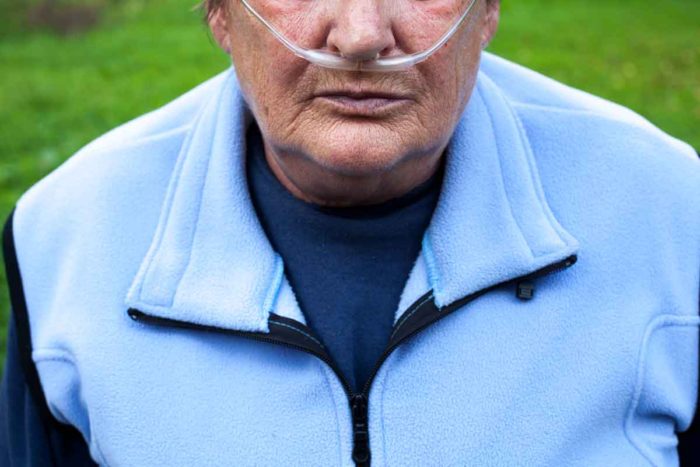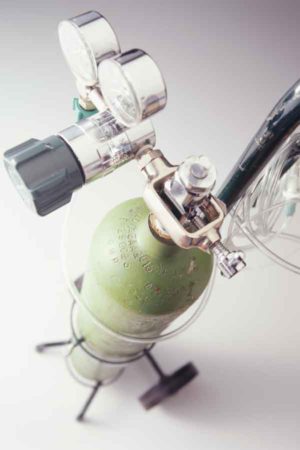For some COPD patients, portable oxygen treatment provides no benefit
Study addresses long-standing questions for those with moderately low blood oxygen levels
 Thinkstock
ThinkstockPortable oxygen treatment does not benefit a large group of patients with chronic obstructive pulmonary disease who have moderately low levels of oxygen in the blood, according to a team of researchers nationwide, including at Washington University School of Medicine in St. Louis.
Patients with chronic obstructive pulmonary disease (COPD) often receive portable oxygen therapy to help raise oxygen levels and allow them to breathe easier. But a major study published Oct. 26 in The New England Journal of Medicine indicates that supplemental oxygen does not benefit a large group of patients with COPD: those with moderately low levels of oxygen in the blood.
For such patients, the clinical trial shows, portable oxygen does not boost survival or reduce hospital admissions. The study was conducted by researchers nationwide, including a team at Washington University School of Medicine in St. Louis.
“This treatment trial — the largest study of supplemental oxygen therapy ever conducted — answers questions about expanding use of oxygen in patients with COPD and using it in patients who have moderately low oxygen levels at rest or during exercise,” said Roger Yusen, MD, an associate professor of medicine and the study’s principal investigator at Washington University. “The findings allow us to further individualize treatment plans for people who have COPD.”
The 738 patients enrolled in the study had COPD and moderately low levels of blood oxygen — in contrast to severely low blood oxygen levels — at rest or during exercise.
 Thinkstock
ThinkstockPrevious research showed that long-term treatment with portable oxygen improves survival in COPD patients with severely low levels of blood oxygen. However, a long-standing question remained about whether COPD patients with moderately low levels of oxygen also would benefit.
For decades, oxygen has been one of the mainstays of treatment for patients with COPD and low oxygen levels. The oxygen is stored as liquid or compressed gas in portable metal tanks or extracted and concentrated from the air, and is typically delivered via a nasal tube or mask.
The study was funded by the National Heart, Lung, and Blood Institute (NHLBI) of the National Institutes of Health (NIH), and the Centers for Medicare & Medicaid Services. It involved patients from 42 medical centers throughout the United States.
COPD, the third leading cause of death in the U.S., is a progressive lung disease triggered primarily by cigarette smoking, although up to 20 percent of COPD patients have never smoked. Symptoms include shortness of breath, chronic coughing and wheezing. The disease also causes low oxygen levels in the blood.
About 15 million people have been diagnosed with COPD in the U.S. and another 10 million may be undiagnosed.
In the new study, patients with moderately low levels of blood oxygen are defined as those with blood oxygen saturation — which is checked with a probe on the finger — of 89 percent to 93 percent at rest, or blood oxygen saturation of 80 percent to 90 percent during a six-minute walking test. Patients with severely low blood oxygen levels are defined as those with blood oxygen saturation at or less than 88 percent at rest or those with blood oxygen saturation below 80 percent during exercise.
“These results provide insight into a long-standing question about oxygen use in patients with COPD and moderately low levels of blood oxygen,” said James P. Kiley, PhD, director of NHLBI’s Division of Lung Diseases. “The findings also underscore the need for new treatments for COPD.”
Patients with COPD should check with their physicians before altering any oxygen treatment plans, Yusen cautioned. “This trial did not address every COPD patient scenario, so it’s important for patients to discuss treatment plans with their physicians before making any changes,” said Yusen, medical director of the Lung Volume Reduction Surgery Program and of a COPD specialty clinic at the School of Medicine and Barnes-Jewish Hospital.
Patients in the study were randomly assigned to receive long-term oxygen therapy or not. The researchers found no significant differences between the two randomized groups based on how long patients survived and the length of time leading to initial hospitalization.
Also, they found no differences in other important benchmarks such as the rate at which patients were hospitalized or experienced worsening of COPD symptoms. Nor did researchers find statistically significant differences between the groups in quality of life, levels of depression or anxiety, lung function or ability to walk for short periods.
Although no cure for COPD exists other than lung transplantation, there are a number of treatment options in addition to supplemental oxygen therapy. These include smoking cessation, bronchodilators, steroids, vaccinations, pulmonary rehabilitation and emphysema resection surgery. Worldwide, researchers also are studying new medications and exploring other approaches such as gene therapy. They continue to emphasize the importance of not smoking tobacco and avoiding the inhalation of combustion products in preventing or slowing the progression of COPD.







